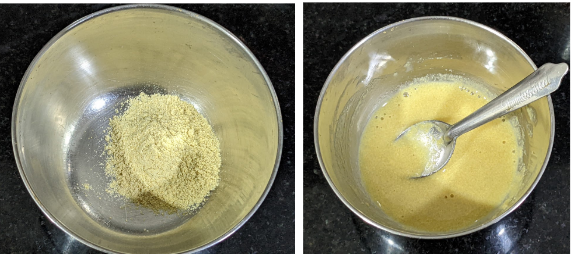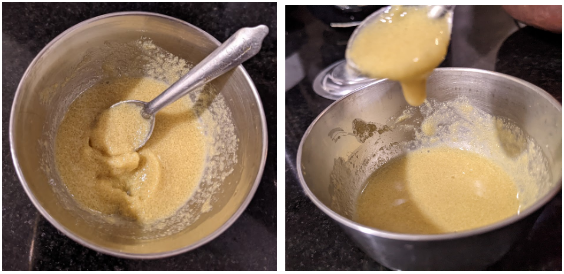How to add fenugreek seeds to idli batter
In a previous post, I had explored the possible reasons why fenugreek seeds are added to the idli recipe. I love their flavour in dosa and add them to the batter every time. But the seeds don’t always grind smoothly despite hours of soaking. In this post, I have shared 4 different methods by which I tried adding fenugreek seeds to idli batter. One of the methods works superbly each time!
Method 1 – Soak and grind with urad dal
I usually use a 4:1 ratio for getting reliably spongy idlis every time. (Here is my post explaining the effect of using different rice:dal ratios). In this method, for every cup of urad dal, I add a teaspoon of fenugreek seeds to the dal itself before washing. I then wash the dal and add double the quantity of water (ie, 2 cups of water for each cup of dal) and leave it to soak for at least 4 hours. Then I add only the soaked grains to the wet grinder along with the soak water and let it grind for 3-4 minutes. Then I add another half-cup of water for every cup of dal. Not at once, but 2-3 spoons of water at a time, in intervals of 5 minutes. This fluffs up the batter upto 3 times in volume (compared to the dry grains and water added).
This method has given me well-fluffed batter every time. But the issue is, sometimes, the fenugreek seeds do not soak fully within this time (maybe they were too dry, not from a fresh batch, or for other reasons). In that case, I do find big grains of the seeds half-ground or even left whole. They simply settle down to the bottom of the batter due to their weight and the flavour does not get infused well.
So, I use this method only when I intend to soak urad dal for at least 8 hours.
Method 2 – Soak and grind with rice
In this method, I add 1 teaspoon of fenugreek seeds (approx 5gm) for every 4 cups of idli rice. I wash them together and soak them for at least 4 hours. The rice usually gets ground to the fine-grainy paste that I want in about 30 minutes of grinding. But as with the previous method, it is a hit-or-miss in the case of fenugreek seeds. Sometimes they grind smoothly and sometimes I can see even whole grains left behind in the batter. Not good for the flavour you want to extract from the fenugreek.
As for a long soaking time, I have not found any reasons (so far) to soak rice beyond 3-4 hours. (Read my post on the preferred soaking time and why it matters). So I tend to avoid this method since it does not reliably give me a smooth batter every time.
Method 3 – Make a paste from fenugreek powder, add to idli batter while mixing
It is great that we get fenugreek seeds in powdered form quite easily these days. Of course, you can powder it in your mixie too. But it takes some effort for the bitter taste and the sticky gum to completely wash off the jar :\ So I stick to using store-bought powder when I follow this method.
I take 1 teaspoon of the powder for every 4 cups of rice (and 1 cup of urad dal). I wash and soak the urad dal and rice separately for 4 hours. Just before starting to grind them, I mix a few teaspoons of water to the fenugreek powder and set it aside.

After a few minutes, the paste would thicken into a gel-like consistency. You can thin it out later by adding a few more teaspoons of water. (The colour in the pictures below is slightly different since it had started getting dark into the evening).

I grind the urad dal first in the wet grinder. I add a few tablespoons of water intermittently to the dal and grind until it fluffs up well (about 25 minutes). After taking it out, I add soaked rice and grind until it has a fine-grain consistency, but is not too smooth. (about 30 minutes). I then mix all three of them together- the urad batter, the rice batter and the fenugreek paste – by hand. (Read my post on different methods for mixing the batters and why/when hand mixing is recommended)
So, you have a wonderfully smooth batter that infuses the fenugreek flavor very well!
But the next method has another advantage.
Method 4 – recommended: soak separately, grind separately then add rice
I came across this method only recently on Suguna Vinoth’s amazing blog (Kannamma Cooks) which has lots of traditional recipes from different regions in Tamil Nadu and elsewhere.
In this method, the proportion of ingredients is the same (1 teaspoon of fenugreek for every 4 cups of rice and 1 cup of urad dal). The soaking time is also the same (4 hours). But I soak the fenugreek seeds separately in a quarter cup of water.

After all three are soaked, I grind the urad dal first (same way as mentioned above) and take out the fluffed up urad batter. Then I add the fenugreek seeds alone to the grinder and let it run for a minute without any water.
Then I add the soaked water of the fenugreek plus a quarter cup more fresh water. In just 5 minutes, the fenugreek is ground not just to a smooth paste but also fluffs up into a foam, very similar to how urad dal does!
Now, I add the soaked rice along with its soak-water to the fenugreek foam and grind the mixture to a fine-grainy consistency (about 30 minutes). Then I mix in the urad batter and set it to ferment.
This method not only gives a smooth, uniform batter with a great infusion of fenugreek flavour. It also makes the batter more fluffy and the idlis turn out spongier. So, this has become my default method for incorporating fenugreek seeds into idlis.
